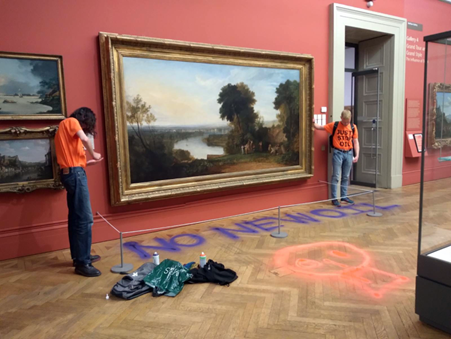Within Edinburgh alone, there has been a collection of recent exhibitions focusing on the environment. The Talbot Rice Gallery has organised The Recent; The City Art Centre has presented Shifting Vistas: 250 Years of Scottish Landscapes and Deep Rooted consecutively; The National Museum of Scotland opened Rising Tide: Art and Environment in Oceana in August. Further afield, in London, the Hayward Gallery ran Dear Earth: Art and Hope in a Time of Crisis over the summer and the Barbican Centre showcased Our Time on Earth in 2022.
Even though artistic contemplation on and intervention in the state of the environment has been a long-running practice, in recent years, the topic has entered the mainstream of art institutions in correlation to the entry of the topic in mainstream consciousness in the form of the climate crisis.
In the upcoming COP28 meeting in Dubai, government officials will fly in on their private jets to discuss how to stay on track with the 2015 Paris Agreement. A 1.2C temperature rise was agreed as the desirable limit for the long-term future, and most policies today are indicating a temperature rise of 2.5-9C by 2100. So, with this in mind, let’s see what art can do – or rather, can’t do about climate change.
When looking at art practice concerning climate change, it is an effective site for raising issues, signalling warning messages and imagining futures. Katie Paterson’s incense stick work – “To Burn,
Forest, Fire, 2022-2023″- is currently being shown at the City Art Centre’s Deep Rooted and the Talbot
Rice Gallery’s The Recent. One stick represents the first forest, which was in New York State, and the other the last forest, in the Amazon; both have tailor-made scents. In The Recent, the sticks are burned every day at 11am or 3 pm for a quiet moment of reflection on the past and future loss of the earth’s lungs.
However, there is an added feature. The gallery is working with university wildfire experts to compile
documents relating to daily wildfires taking place across the globe. The day’s documents are placed
on display with each incense stick burning, so the work is connected to present-day loss. This
connection perhaps makes the work more than a ‘sensory experience,’ as the City Art Centre
describes it. It is an urgent statement of the effects of climate change taking place, daily, and
offering it to the gallery visitors. It is a subtle, calm, reflective artwork.
But what if we look at the subject differently, climate change interacting with art? For this, a clear example is Just Stop Oil’s repetitive antagonism of major art institutions and direct aggression towards works of art, most recently, the hammering of Diego Velázquez’s Rokeby Venus c. 1647-51, in the National Gallery. While you may not view this as art, it is an important reminder that the art world is not removed from the climate crisis. These galleries, museums and artists are not autonomous spheres, capable of gracious climate change critique and immune from being critiqued in return.
Some may look at this act and think, ‘Well, that’s pointless, what are they hoping to achieve?’ others may fan themselves with shock and dismay, exclaiming ‘How could they? What has the artwork done to deserve this?’ The real question is, how could the institutions? Rather than shoot the messenger, why not investigate why they deliver the message?
See, one thing the art world is very good at is absorbing critique into standard institutional art practice, and spitting out sustainability promises in press releases, workshops on creative recycling and art pieces that ultimately reflect on crises, but rarely take action. Art is a site for addressing contemporary issues, but the reality of how the system itself functions as a workplace sponsored by oil companies, flying in artworks for temporary blockbuster exhibitions and producing copious merchandise, doesn’t change. The art world is not removed from the climate crisis, they are complicit in their practices, so maybe it will take a collective outside of this art world to truly awaken it to its complicity. And, unfortunately, it will mean quite a bit of antagonism.
“Just Stop Oil Manchester Art Gallery 01072022” by Just Stop Oil is licensed under CC BY-SA 4.0.

